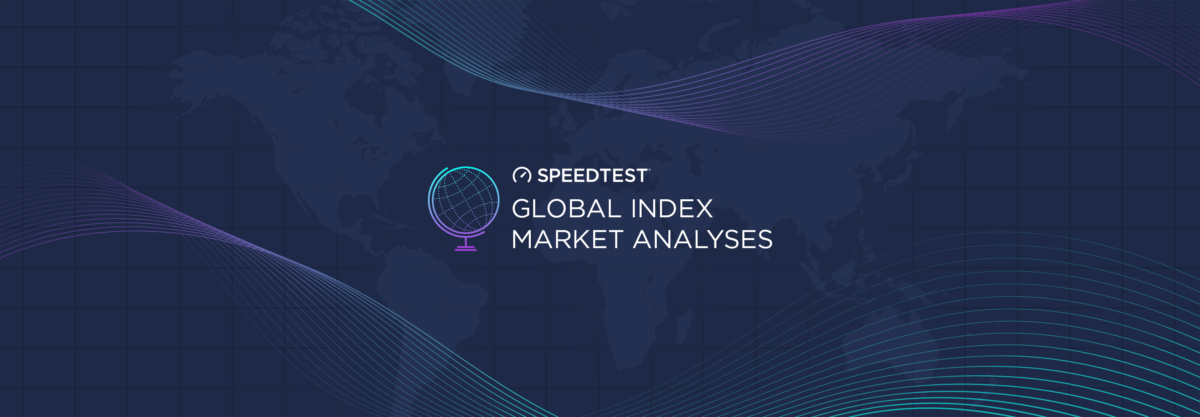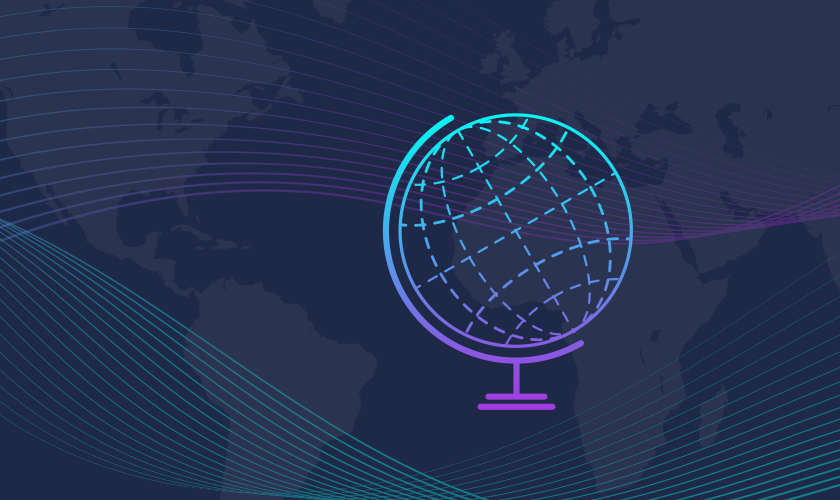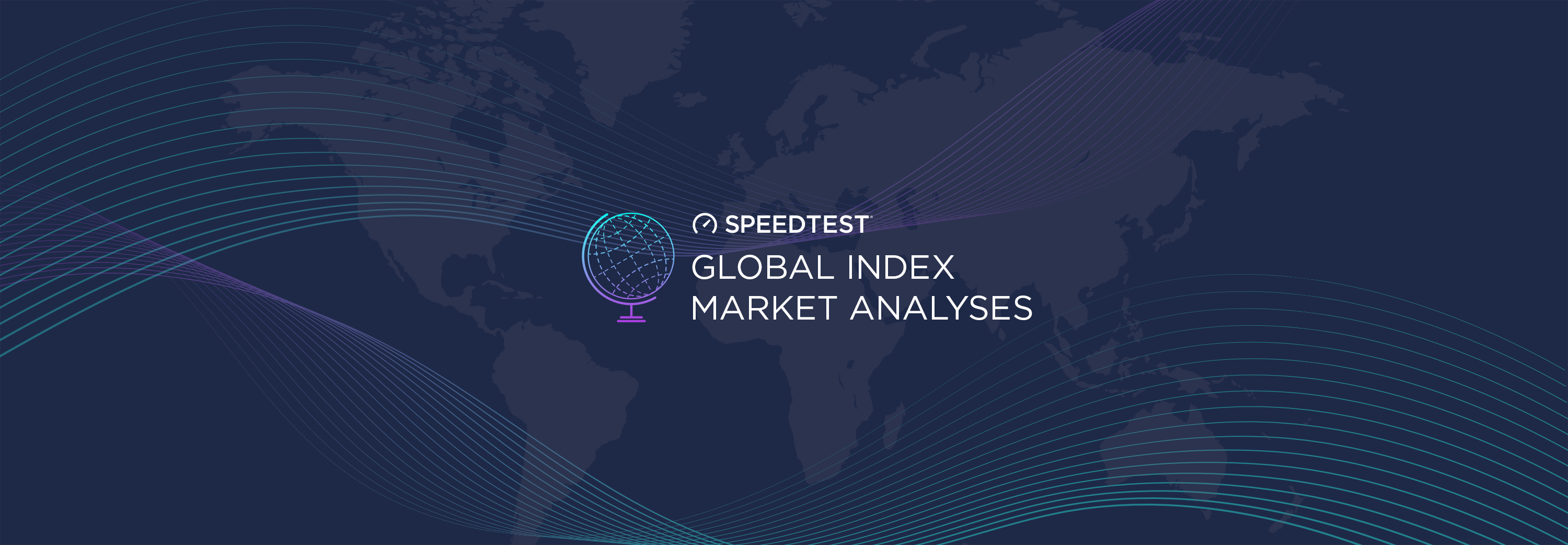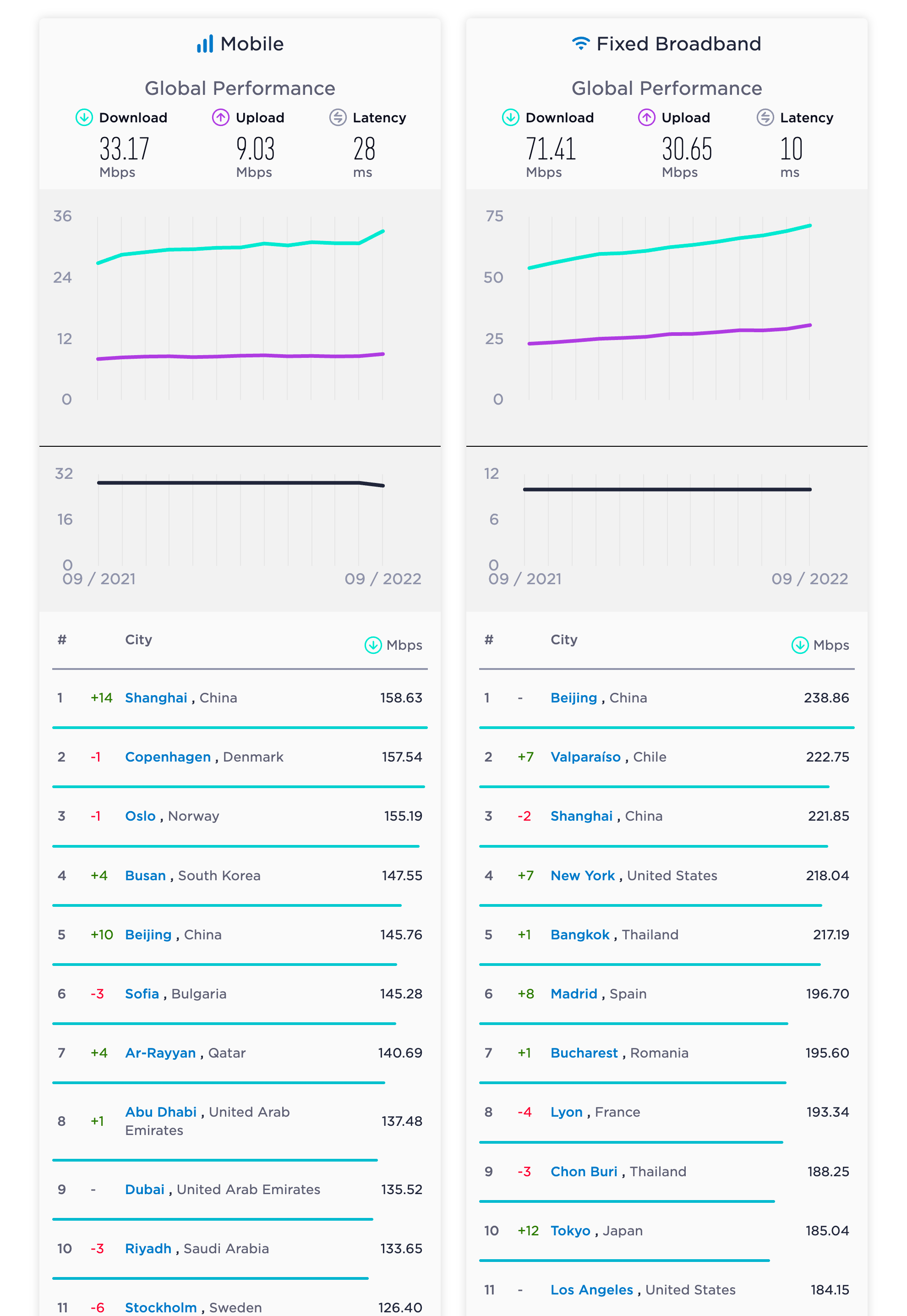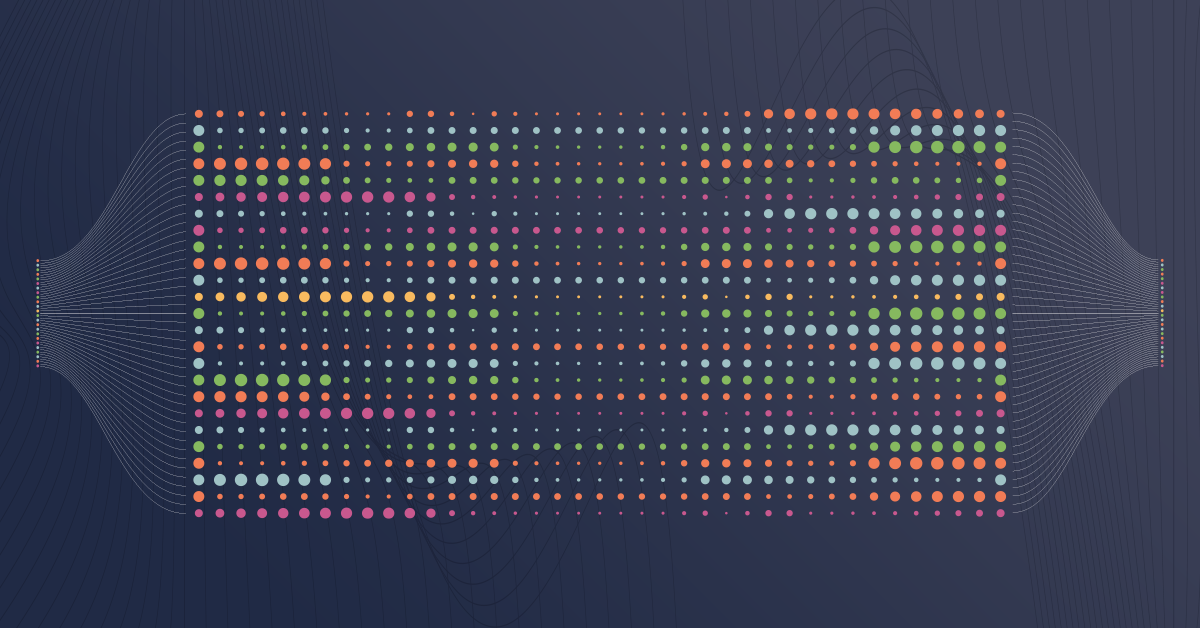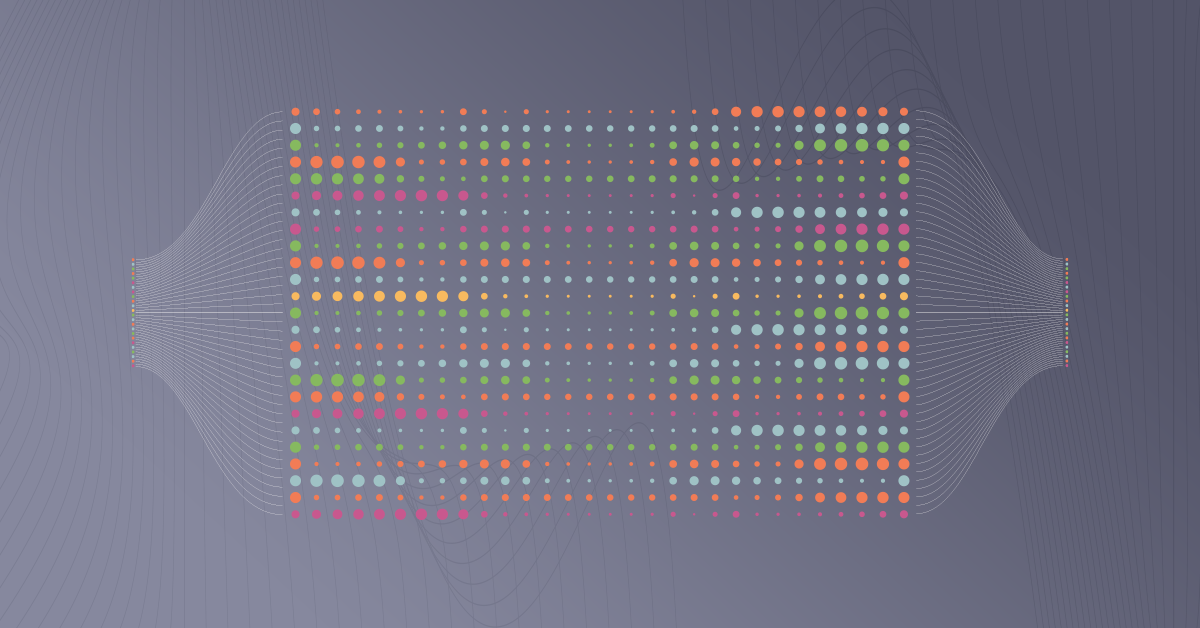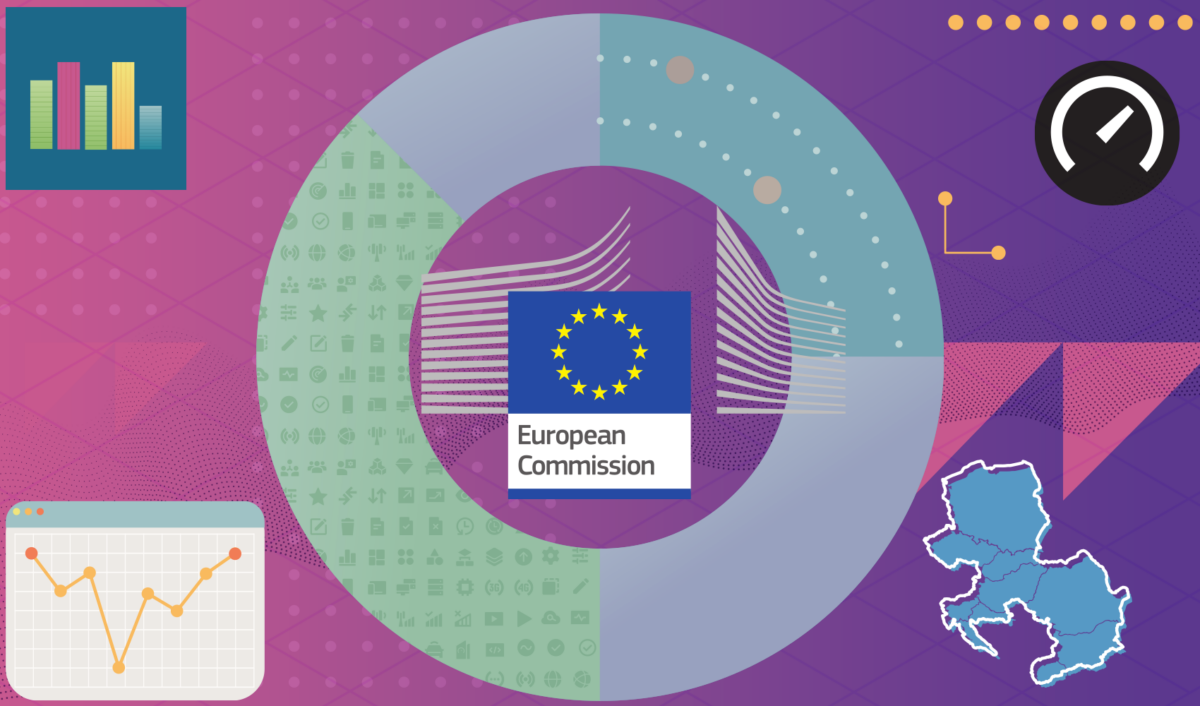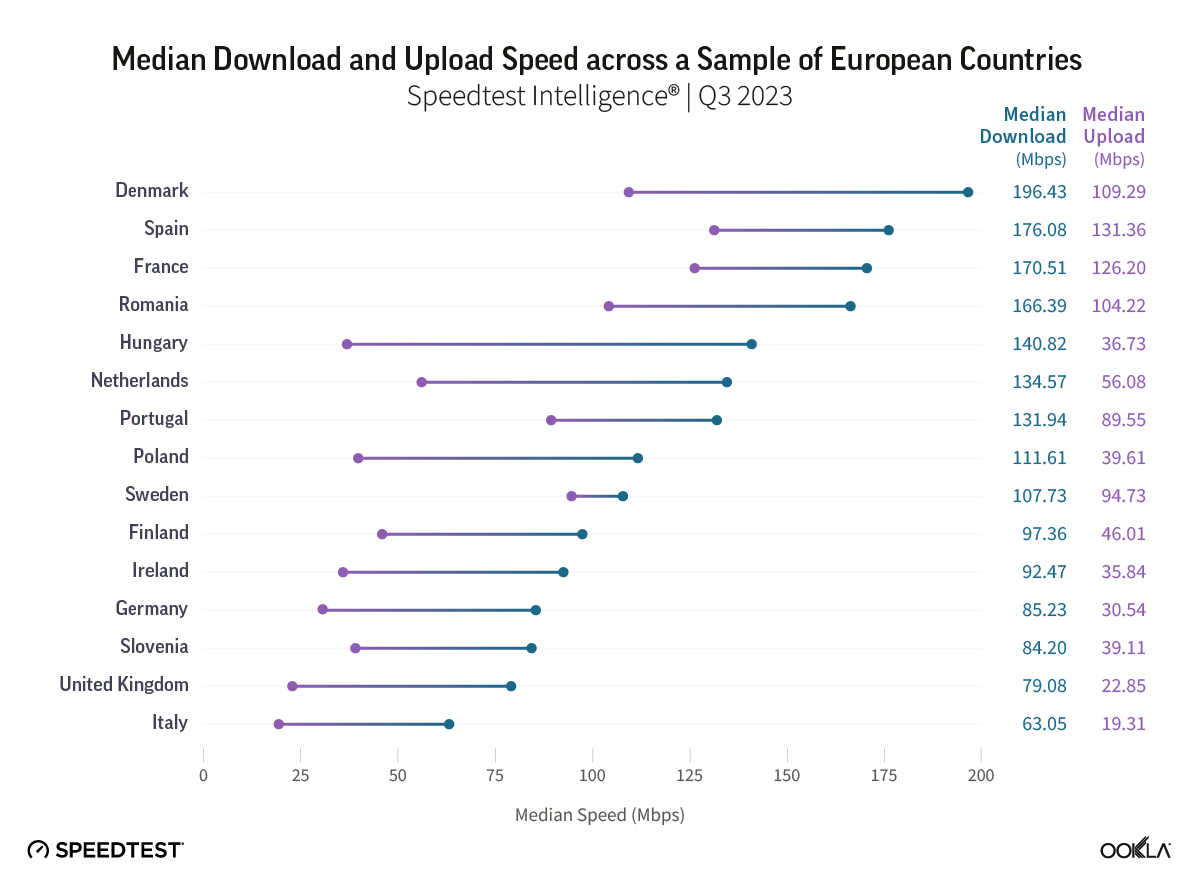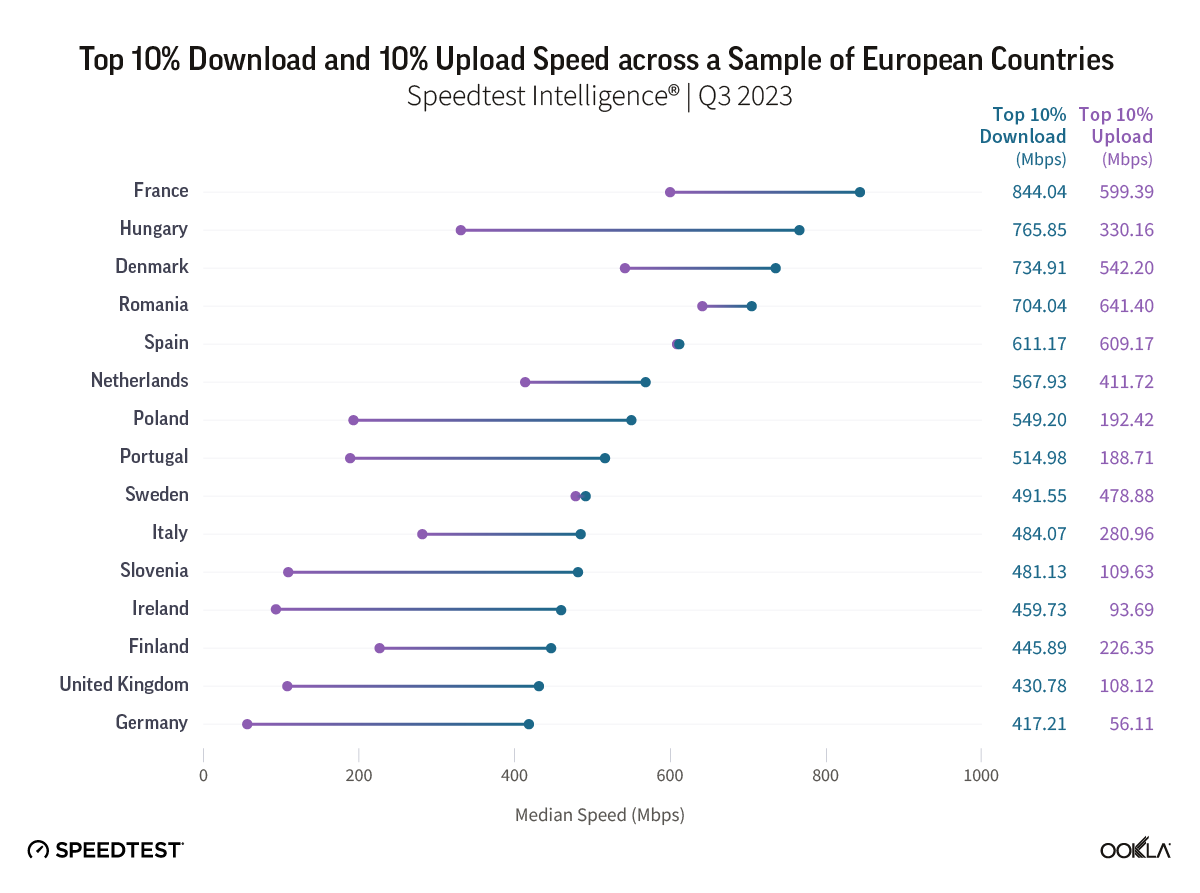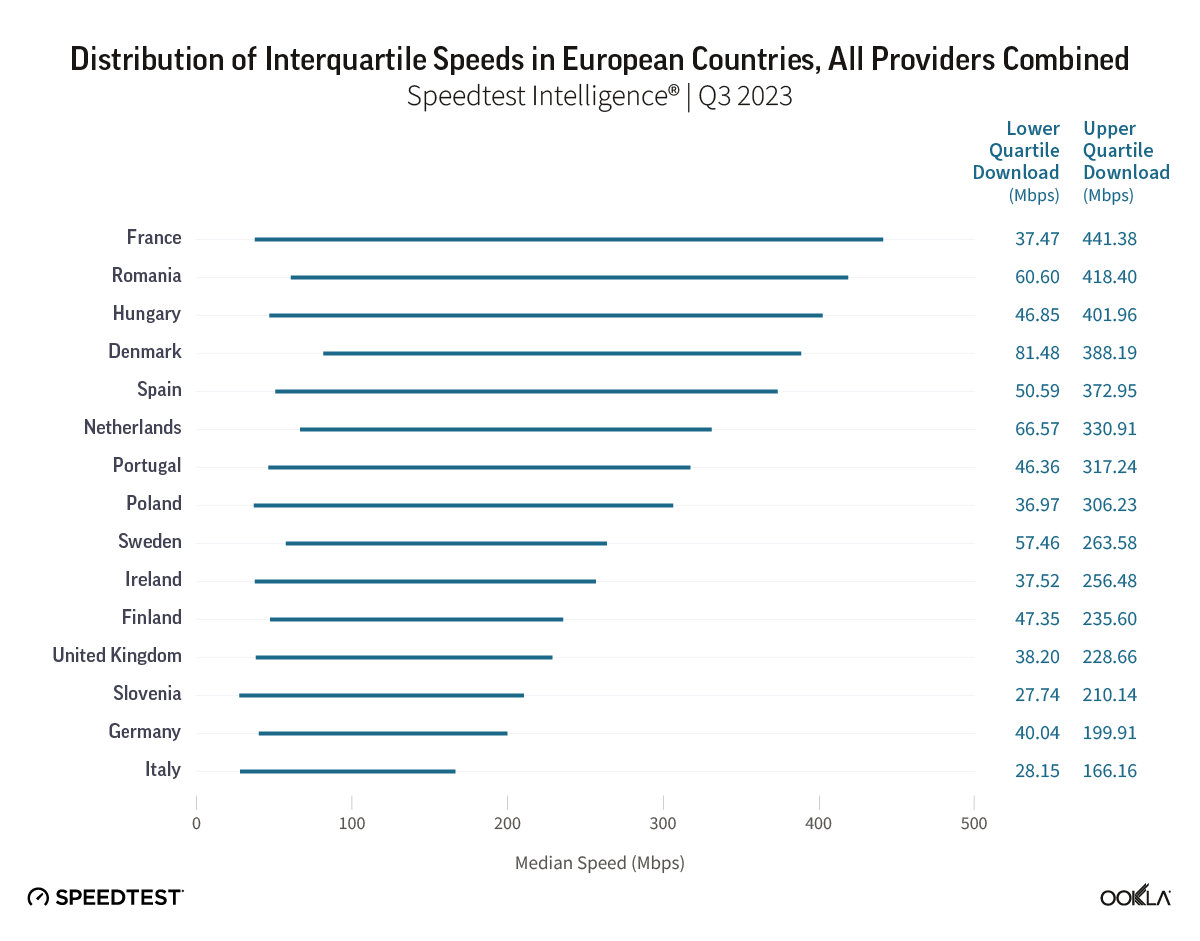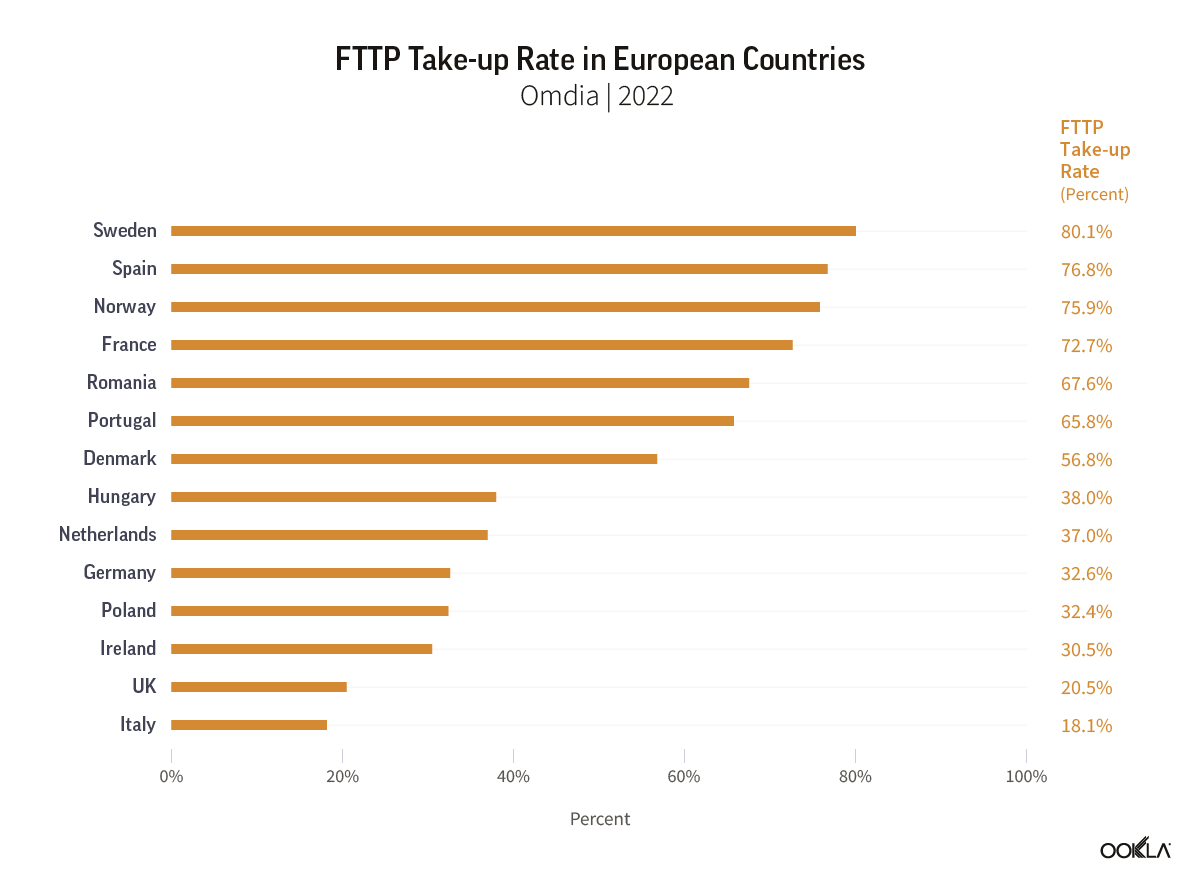Speedtest Global IndexTM Market Analyses from Ookla® identify key data about internet performance in countries across the world. This quarter we’ve provided updated analyses for 41 markets that includes details on fastest mobile and fixed broadband providers, performance of most popular devices and chipsets and internet speeds in cities. Click a country on the list below to see highlights or scroll through the article to learn what Speedtest Intelligence® revealed in all 41 markets:
Africa and the Middle East
Algeria | Jordan | Kenya | Morocco | Nigeria
Qatar | South Africa | Tunisia | Turkey
Asia and Oceania
China | Hong Kong (SAR) | New Zealand | Philippines | Singapore
Taiwan | Thailand | Vietnam
Europe
Austria | Belgium | Czechia | Denmark | Estonia
Finland| France | Germany | Hungary | Luxembourg
Malta | Poland | Slovakia | Spain
North and South America
Argentina | Brazil | Canada | Chile | Colombia
Ecuador | Guatemala | Mexico | Peru | United States
Africa and the Middle East
Algeria
- Mobile provider Ooredoo had the highest Speed Score™ (25.05) and Consistency Score™ (82.0%) in Algeria during Q4 2021.
- Apple devices were the fastest devices in Algeria during Q4 2021, achieving a mean download speed of 26.44 Mbps.
- Xiaomi’s Redmi K40 5G and Apple’s iPhone 12 Pro Max 5G took the top spots among popular devices with mean download speeds at 35.71 Mbps and 35.40 Mbps, respectively, during Q4 2021.
Jordan
- Speedtest Intelligence found Umniah was once again the fastest mobile operator in Jordan during Q4 2021, earning a Speed Score of 34.82.
- Umniah also had the highest Consistency Score at 94.2% during Q4 2021.
- For the third quarter in a row, fixed broadband provider Orange held the fastest Speed Score at 81.62 during Q4 2021.
- Fixed broadband provider DAMAMAX had the highest Consistency Score at 86.2% during Q4 2021.
- Among popular mobile devices in Jordan, Apple’s iPhone 12 Pro Max 5G edged out the iPhone 12 5G for fastest median download at 38.91 Mbps to 38.35 Mbps, respectively, during Q4 2021.
- Amman had the fastest median fixed broadband and mobile download speeds among Jordan’s most populous cities at 57.31 Mbps and 19.99 Mbps, respectively, during Q4 2021.
Kenya
- Mobile provider Safaricom had the highest mobile Speed Score (29.67) in Kenya during Q4 2021.
- Airtel edged out Safaricom for highest mobile Consistency Score (83.1%) during Q4 2021.
- For fixed broadband, Faiba had the highest Speed Score (28.58) and Consistency Score (52.0%) in Kenya for the third quarter in a row during Q4 2021.
- Apple took four out of the top five spots among popular devices in Kenya during Q4 2021, with the iPhone 12 Pro Max 5G achieving the highest mean download speed at 39.19 Mbps.
- Mombasa had the fastest mean mobile download and upload speeds among Kenya’s most populous cities at 30.32 Mbps and 17.05 Mbps, respectively.
- Mombasa also had the fastest mean fixed broadband download speed at 22.91 Mbps during Q4 2021.
Morocco
- Mobile operator Maroc Telecom achieved the highest Speed Score (67.26) and Consistency Score (93.4%) during Q4 2021, both increases from Q3 2021 results.
- Salé (44.92 Mbps), Marrakesh (44.32 Mbps) and Fes (43.57 Mbps) took the top spots for fastest mean mobile download speeds among Morocco’s most populous cities during Q4 2021.
Nigeria
- For the fourth quarter in a row, mobile provider Airtel had the fastest Speed Score in Nigeria at 35.35 during Q4 2021 — a slight increase from 33.43 during Q3 2021.
- Airtel maintained the top spot for highest Consistency Score on mobile during Q4 2021 at 87.5% to MTN’s 85.8%.
- Fixed broadband provider ipNX once again had the fastest Speed Score (22.05) and highest Consistency Score (42.8%) in Nigeria during Q4 2021.
- The iPhone 12 Pro 5G was the fastest popular device in Nigeria during Q4 2021, achieving a mean download speed of 47.20 Mbps.
- Kano retained the top spot among Nigeria’s most populous cities for fastest mean mobile download speed at 29.35 Mbps during Q4 2021.
Qatar
- Ooredoo had the fastest Speed Score over mobile in Qatar for the third quarter in a row at 156.85 during Q4 2021.
- 5G performance in Qatar was extremely competitive with Vodafone overtaking Ooredoo for the fastest median 5G download speed during Q4 2021 at 421.42 Mbps to Ooredoo’s 390.59 Mbps.
- Vodafone had the highest mobile Consistency Score in Qatar at 93.2%, beating out Ooredoo’s 87.7% during Q4 2021.
- Ooredoo had the fastest fixed broadband Speed Score at 77.45 and highest Consistency Score at 81.1% in Qatar during Q4 2021.
- Apple’s iPhone 13 Pro Max beat out the iPhone 13 Pro for fastest popular device in Qatar during Q4 2021 with a median download speed of 431.49 Mbps to 399.06 Mbps, respectively. All top five devices during Q4 2021 achieved median download speeds greater than 240 Mbps.
- Al Khor once again had the fastest median mobile download speed among Qatar’s most populous cities at 137.43 Mbps during Q4 2021 .
- Umm Salal Muhammed had the fastest fixed broadband download speeds in Qatar at 90.79 Mbps during Q4 2021.
South Africa
- Speedtest Intelligence shows Cool Ideas had the fastest fixed broadband Speed Score (54.46) and highest Consistency Score (73.0%) for the second quarter in a row during Q4 2021.
- Among mobile operators, MTN had the fastest Speed Score (65.21) and highest Consistency Score (89.1%) during Q4 2021.
- Apple devices had the fastest combined median download speed in South Africa at 37.98 Mbps and fastest median upload speed at 7.66 Mbps during Q4 2021.
- The iPhone 13 Pro Max took top honors as the fastest popular device in South Africa during Q4 2021, achieving a median download speed of 97.59 Mbps, much faster than the Q3 2021 winning speed of 79.56 Mbps.
Tunisia
- During Q4 2021, Ooredoo achieved the highest mobile Speed Score in Tunisia at 51.46, a slight increase from Q3 2021.
- Tunisie Telecom had the highest fixed broadband Speed Score in Tunisia at 10.70 Mbps during Q4 2021.
- Apple’s iPhone 13 Pro Max had the fastest mean download speed in Tunisia among popular devices at 77.55 Mbps during Q4 2021.
- Among popular chipsets, Qualcomm’s Snapdragon X60 5G had the fastest mean download speed in Tunisia at 77.08 Mbps during Q4 2021.
- Gabes and Kairouan had the fastest mean mobile download speeds among Tunisia’s most populous cities at 50.78 Mbps and 50.47 Mbps, respectively, during Q4 2021.
Turkey
- Speedtest Intelligence revealed mobile provider Turkcell had the highest Speed Score and Consistency Score in Turkey during Q4 2021 at 71.49 and 94.6%, respectively. Both scores were slight increases from Q3 2021.
- For fixed broadband in Turkey, TurkNet had the highest Speed Score (44.60) and Consistency Score (75.0%) during Q4 2021.
- Istanbul had the fastest mean fixed broadband and mobile download speed among Turkey’s most populous cities at 53.29 Mbps and 54.05 Mbps, respectively, during Q4 2021.
- Among top device manufacturers, Apple beat out Samsung for fastest mean download speed in Turkey at 59.20 Mbps to 45.02 Mbps, respectively, both slight increases from Q3 2021.
Asia and Oceania
China
- According to Speedtest Intelligence, China Telecom was the fastest fixed broadband provider in China during Q4 2021 with a Speed Score of 152.31, a moderate gain over Q3 2021.
- On mobile, China Mobile achieved the highest Speed Score (161.10) and Consistency Score (92.9%) among China’s top providers during Q4 2021 — both increases from Q3 2021.
- During Q4 2021, China Telecom achieved the fastest median 5G download speed at 300.00 Mbps, ahead of China Mobile (295.44 Mbps) and China Unicom (287.73 Mbps).
- Among top device manufacturers, Huawei had the fastest median download speed at 130.28 Mbps in China during Q4 2021 — a substantial gain over Q3 2021’s top speed of 96.66 Mbps. Oppo followed at 103.57 Mbps, then Apple (101.52 Mbps), Vivo (98.26 Mbps) and OnePlus (94.78 Mbps).
- Among popular devices in China, Huawei’s Mate 40 Pro 5G edged out Apple’s iPhone 13 Pro Max for the fastest median download speed during Q4 2021 at 284.81 Mbps to 270.06 Mbps. All five top devices achieved download speeds above 250 Mbps.
- During Q4 2021, MediaTek’s Dimensity 700 5G chipset had the fastest median download speed in China at 291.77 Mbps during Q4 2021.
- Tianjin once again had the fastest median fixed broadband download speed among China’s most populous cities at 247.84 Mbps, a moderate rise from its Q3 2021 results.
- Tianjin also had the fastest median mobile download speed among China’s most populous cities at 139.19 Mbps during Q4 2021, edging out Shenzhen’s 130.27 Mbps. Across all major cities, there was a noticeable rise in speeds from Q3 2021 results.
Hong Kong (SAR)
- China Mobile Hong Kong was the fastest mobile operator in Hong Kong for the fourth quarter in a row, earning a Speed Score of 84.79 in Q4 2021, a moderate increase from Q3 2021.
- China Mobile Hong Kong once again showed the fastest 5G download speed, achieving a median speed of 179.20 Mbps during Q4 2021, a decline from its Q3 2021 results. Mobile provider 3 followed at 169.40 Mbps, then SmarTone at 148.15 Mbps and csl at 127.24 Mbps.
- Among top device manufacturers in Hong Kong during Q4 2021, Apple overtook Samsung for fastest median download speed 50.30 Mbps to 45.20 Mbps.
- During Q4 2021, the iPhone 13 Pro Max retained the top spot among popular devices in Hong Kong with a median download speed of 128.22 Mbps.
- Qualcomm’s Snapdragon X60 5G was the fastest chipset in Hong Kong for median download speed at 114.13 Mbps during Q4 2021.
New Zealand
- During Q4 2021, Vodafone was the fastest mobile operator in New Zealand, earning a Speed Score of 83.72, a moderate increase from Q3 2021.
- Vodafone also achieved the fastest median 5G download speed in New Zealand at 344.06 Mbps during Q4 2021, an increase from Q3 2021. Spark followed at 298.85 Mbps.
- For fixed broadband, MyRepublic blazed ahead in New Zealand with a Speed Score of 233.83 during Q4 2021.
- The Apple iPhone 13 had the fastest median download speed among popular devices in New Zealand at 193.18 during Q4 2021, a huge increase over Q3 2021’s top speed of 92.26 Mbps.
- Among popular device manufacturers, Apple took the top spot for the fastest median download speed in New Zealand at 51.64 Mbps during Q4 2021.
- Hamilton overtook Christchurch for the fastest median mobile download speed at 80.98 Mbps during Q4 2021.
- Wellington took the top spot for fastest median fixed broadband download and upload speed at 133.59 Mbps and 84.21 Mbps, respectively, during Q4 2021.
Philippines
- During Q4 2021, Smart had the highest Speed Score (68.78) among top mobile operators in the Philippines, a moderate increase from Q3 2021.
- Smart also had the fastest median 5G download speed in the Philippines during Q4 2021 at 220.89 Mbps, much faster than Globe’s 117.93 Mbps.
- Competition for the fastest popular device wasn’t close during Q4 2021, with the iPhone 13 Pro Max dominating the closest competitor — the Samsung Galaxy S21 Ultra 5G — for fastest median download at 113.82 Mbps to 78.89 Mbps.
- Caloocan retained top spot for fastest median download speed among the Philippines’ most populous cities at 25.24 Mbps during Q4 2021, a slight increase from its top speed in Q3 2021 of 22.05 Mbps.
Singapore
- Speedtest Intelligence shows MyRepublic overtook ViewQuest as the fastest fixed broadband provider in Singapore in Q4 2021, achieving a Speed Score of 258.01 to ViewQuest’s 254.53.
- Singtel was the fastest mobile provider in Singapore during Q4 2021, achieving a Speed Score of 113.80, a moderate increase from its Q3 2021 Speed Score of 99.74.
- Singtel also blazed ahead of the competition for fastest median 5G download speed in Singapore at 289.01 Mbps during Q4 2021 — a notable rise from its median 5G download speed of 248.45 during Q3 2021.
- The Apple iPhone 13 Pro Max was the fastest popular device in Singapore during Q4 2021, achieving a median download speed of 138.40 Mbps.
- Apple beat out Samsung for fastest device manufacturer in Singapore during Q4 2021, with Apple devices achieving a median download speed of 75.81 Mbps to Samsung’s 64.68 Mbps.
Taiwan
- During Q4 2021, Chunghwa Telecom had the fastest median 5G download speed in Taiwan at 429.63 Mbps. FarEasTone followed at 309.35 Mbps, then Taiwan Mobile (285.05 Mbps), GT (242.23 Mbps) and TSTAR (147.95 Mbps).
- FarEasTone had the highest Consistency Score in Taiwan during Q4 2021 at 93.9%, followed closely by Chunghwa Telecom (92.1%) and Taiwan Mobile (91.9%).
- Among top device manufacturers during Q4 2021, Apple devices achieved the fastest median download speed in Taiwan at 63.02 Mbps, a moderate increase over Q3 2021.
- The Apple iPhone 13 Pro Max had the fastest median download speed among popular devices in Taiwan at 168.43 Mbps during Q4 2021.
- The Qualcomm Snapdragon X60 5G had the fastest median download speed among popular chipsets in Taiwan at 139.56 Mbps during Q4 2021.
- Taipei had the fastest median mobile download speed among Taiwan’s most populous cities at 56.60 Mbps in Q4 2021, followed by New Taipei (52.54 Mbps), Taichung (51.69 Mbps) and Taoyuan (51.47 Mbps).
Thailand
- Speedtest Intelligence revealed that AIS had the fastest Speed Score on mobile in Thailand at 74.02 during Q4 2021, beating out TrueMove H (68.12) and dtac (26.05).
- AIS also had the fastest median 5G download speed in Thailand during Q4 2021 at 289.12 Mbps, followed by TrueMove H (217.84 Mbps) and dtac (35.73 Mbps).
- Apple was the fastest major device manufacturer in Thailand with Apple devices achieving a median download speed of 43.82 Mbps during Q4 2021.
- The Apple iPhone 13 Pro Max was the fastest popular device in Thailand, edging out the iPhone 13 Pro for fastest median download at 158.97 Mbps to 152.09 Mbps during Q4 2021.
Vietnam
- Viettel once again claimed the top spot as Vietnam’s fastest mobile provider during Q4 2021, earning a mobile Speed Score of 48.23, just faster than Vinaphone (45.51).
- Viettel overtook Vinaphone for the highest mobile Consistency Score in Vietnam during Q4 2021 at 91.2%.
- For fixed broadband, Vinaphone overtook Viettel as Vietnam’s fastest fixed broadband provider during Q4 2021, earning a Speed Score of 75.49 to Viettel’s 73.38. FPT Telecom followed at 71.10.
- Apple’s iPhone 13 Pro Max had the fastest median download speed among popular devices in Vietnam at 72.39 Mbps during Q4 2021.
- Ho Chi Minh City retained the top spot for the fastest median fixed broadband download and upload speeds among Vietnam’s most populous cities at 75.10 Mbps and 72.48 Mbps, respectively, during Q4 2021.
- Da Nang retained the top spot for fastest median mobile download speed among Vietnam’s most populous cities at 43.88 Mbps during Q4 2021.
Europe
Austria
- Magenta retained its top spot as Austria’s fastest fixed broadband provider with a Speed Score of 123.76 during Q4 2021. LIWEST was the closest competitor (85.16).
- Magenta also had the highest Consistency Score in Austria for fixed broadband at 88.7% in Q4 2021.
- A1 was once again the fastest mobile provider in Austria during Q4 2021, achieving a Speed Score of 74.06. Operator 3 followed at 58.01.
- A1 also had the highest mobile Consistency Score in Austria during Q4 2021 at 93.2%.
- The Apple iPhone 13 Pro Max had the fastest median download speed among popular devices in Austria at 116.24 Mbps during Q4 2021.
Belgium
- Telenet decisively claimed its spot as Belgium’s fastest fixed broadband provider during Q4 2021, earning a Speed Score of 128.13. VOO followed at 109.76.
- Among mobile operators, Telenet edged out BASE for the fastest Speed Score in Belgium at 65.61 to 65.59, respectively, during Q4 2021. It should be noted that Telenet owns the BASE brand. Proximus followed at 62.96 then Orange at 47.23.
- Competition for fastest popular mobile device was tight in Belgium, with the iPhone 13 mini and iPhone 13 Pro achieving median download speeds of 98.53 Mbps and 98.31 Mbps, respectively.
- Once again, Ghent retained its top place for fastest median mobile download speed among Belgium’s most populous cities, achieving a median speed of 79.69 Mbps during Q4 2021.
- Competition for the fastest median fixed broadband download speed among Belgium’s most populous cities was close with Antwerp achieving a median download speed at 83.51 Mbps and Ghent achieving 83.02 Mbps during Q4 2021.
Czechia
- Speedtest Intelligence reveals T-Mobile was Czechia’s fastest mobile provider during Q4 2021, earning a Speed Score of 69.69, a moderate increase from 58.82 during Q3 2021.
- Competition was extremely tight for highest mobile Consistency Score in Czechia during Q4 2021, with T-Mobile achieving 93.9%, followed by O2 (93.4%) and Vodafone (93.2%).
- Vodafone dominated as Czechia’s fastest fixed broadband provider during Q4 2021, achieving a Speed Score of 99.16, a slight increase from Q3 2021.
- Vodafone once again had Czechia’s highest Consistency Score for fixed broadband during Q4 2021 at 77.6%.
- Pilsen had the fastest median fixed broadband speed among Czechia’s most populous cities during Q4 2021, achieving a median download of 59.37 Mbps.
- Pilsen edged out Brno for the fastest median mobile download speed at 63.65 Mbps to Brno’s 63.26 Mbps during Q4 2021.
Denmark
- Fastspeed was once again Denmark’s fastest fixed broadband provider, earning a Speed Score of 301.58 during Q4 2021. Hiper followed at 260.78.
- YouSee overtook Telenor as Denmark’s fastest mobile operator, earning a Speed Score of 101.72 to Telenor’s 91.91. Telia (89.84) and 3 (77.89) followed.
- An analysis of performance on some of the most popular phones in Denmark revealed the iPhone 13 Pro edged out the iPhone 13 Pro Max for the fastest median download speed during Q4 2021 148.17 Mbps to 144.68 Mbps.
Estonia
- According to Speedtest Intelligence, Elisa was the fastest fixed broadband provider in Estonia during Q4 2021, achieving a Speed Score of 85.58.
- Telia once again had the fastest mobile Speed Score in Estonia at 85.27 during Q4 2021, a slight increase from Q3 2021.
- The Apple iPhone 13 Pro was the fastest popular device in Estonia, earning a median download speed of 107.31 Mbps during Q4 2021. The iPhone 13 Pro Max followed closely at 105.15 Mbps.
- Among major cell phone manufacturers, OnePlus had the fastest median download speed in Estonia at 70.40 Mbps during Q4 2021, a moderate increase from Q3 2021.
Finland
- According to Speedtest Intelligence, DNA retained its top spot as Finland’s fastest mobile provider in Q4 2021, earning a Speed Score of 86.43, a moderate increase from 79.26 during Q3 2021. DNA also edged out Telia for the highest Consistency Score 94.2% to 92.5%.
- Telia beat out Elisa and DNA in Q4 2021 for the fastest 5G download speed in Finland, achieving a median download speed of 273.07 Mbps to DNA’s 243.87 Mbps and Elisa’s 231.13 Mbps.
- Lounea overtook Telia as the fastest fixed broadband provider in Finland during Q4 2021, earning a Speed Score of 122.33 to Telia and Elisa’s 98.06.
- Lounea also took the top spot for Finland’s highest fixed broadband Consistency Score at 90.2% during Q4 2021.
- Among popular device manufacturers, OnePlus had the fastest median download speed in Finland at 80.49 Mbps during Q4 2021, a moderate increase from Q3 2021. However, the Apple iPhone 13 Pro Max had the fastest median download speed among popular devices at 157.23 Mbps.
France
- Speedtest Intelligence revealed a fierce competition for France’s fastest fixed broadband provider during Q4 2021, with Bouygues narrowly edging out Free and Orange with a Speed Score of 135.66 to 134.09 and 134.07, respectively.
- Orange once again earned the top spot as France’s fastest and most consistent mobile provider with a mobile Speed Score of 99.88 and a Consistency Score of 90.5% during Q4 2021.
- During Q4 2021, Orange blew away the competition as France’s fastest 5G provider by achieving a median 5G download speed of 342.29 Mbps, slightly slower than in Q3 2021. SFR followed at 232.09 Mbps.
- The Apple iPhone 13 Pro Max was the fastest popular device in France during Q4 2021, edging out the iPhone 13 Pro with a median download speed of 149.83 Mbps to 136.57 Mbps.
- During Q4 2021, Lyon achieved the fastest median fixed broadband download and upload speeds at 161.82 Mbps and 109.91 Mbps, respectively. Nice had the fastest median mobile download speed at 88.39 Mbps.
Germany
- According to Speedtest Intelligence, Vodafone was once again Germany’s fastest fixed broadband provider during Q4 2021, earning a Speed Score of 130.99.
- Telekom achieved the highest Speed Score (91.86) and Consistency Score (91.5%) among German mobile operators during Q4 2021.
- Telekom retained the top spot for the fastest median 5G download speed in Germany at 187.99 Mbps during Q4 2021.
- The iPhone 13 Pro Max had the fastest median download speed among popular devices in Germany during Q4 2021, edging out the iPhone 13 Pro 131.71 Mbps to 127.45 Mbps.
Hungary
- Vodafone retained its top spot as Hungary’s fastest fixed broadband provider in Q4 2021, edging out Telekom with a Speed Score of 156.98 to 151.40. Vodafone also had the highest Consistency Score at 87.2% during Q4 2021.
- Telenor overtook Magyar Telekom as Hungary’s fastest and most consistent mobile provider during Q4 2021, earning a Speed Score of 69.40 and Consistency Score of 90.8%.
- Apple devices took the top spot among major device manufacturers in Hungary during Q4 2021, achieving a median download speed of 45.14 Mbps, a slight increase from Q3 2021.
- The Apple 13 Pro dominated as the fastest popular device in Hungary during Q4 2021, achieving a median download speed of 93.66 Mbps.
Luxembourg
- Eltrona overtook Tango as Luxembourg’s fastest fixed broadband provider during Q4 2021 by achieving a Speed Score of 131.60 to Tango’s 127.96.
- POST was again the fastest mobile operator in Luxembourg during Q4 2021, achieving a large increase in Speed Score from 109.64 in Q3 2021 to 123.86 in Q4 2021.
- POST also remained the most consistent mobile operator in Luxembourg with a Consistency Score of 96.9% during Q4 2021.
- The iPhone 13 Pro was the fastest popular device in Luxembourg, achieving a median download speed of 161.69 Mbps during Q4 2021.
- Differdange once again achieved the fastest median fixed broadband download and upload speeds among Luxembourg’s most populous cities at 140.24 Mbps and 94.55 Mbps, respectively, during Q4 2021.
- Ettelbruck had the fastest median mobile download speed in Luxembourg at 113.73 Mbps Q4 2021.
Malta
- Melita retained its top spot as Malta’s fastest and most consistent fixed broadband provider during Q4 2021, earning a Speed Score of 128.11 and Consistency Score of 84.6%, both moderate increases from Q3 2021.
Poland
- Speedtest Intelligence revealed that UPC was the fastest and most consistent fixed broadband provider in Poland during Q4 2021 achieving a Speed Score of 184.12 and Consistency Score of 88.8%.
- T-Mobile had the highest Speed Score and Consistency Score among mobile operators in Poland during Q4 2021 at 61.88 and 93.7%, respectively.
- Mobile operator Plus had the fastest median 5G download speed in Poland at 158.74 Mbps during Q4 2021.
- The iPhone 13 Pro Max was the fastest popular device in Poland during Q4 2021, achieving a median download speed of 81.93 Mbps.
- Warsaw had the fastest fixed broadband download speed among Poland’s most populous cities at 132.99 Mbps during Q4 2021.
- Łódz edged out Warsaw for the fastest mobile download speed in Poland 47.23 Mbps to 45.09 Mbps.
Slovakia
- Orange retained the top spot as Slovakia’s fastest mobile operator during Q4 2021 with a Speed Score of 60.65, edging out Telekom’s 57.50.
- Telekom had the highest mobile Consistency Score in Slovakia during Q4 2021 at 93.4%.
- UPC retained its top spot as Slovakia’s fastest and most consistent fixed broadband provider with a Speed Score of 145.52 and a Consistency Score of 87.3%.
- The Apple iPhone 13 Pro had the fastest median download speed among popular devices in Slovakia at 80.74 Mbps during Q4 2021.
Spain
- Movistar once again provided the fastest and most consistent mobile experience among Spanish mobile providers with a Speed Score of 62.67 and Consistency Score of 90.9% during Q4 2021 — both moderate increases from Q3 2021.
- Vodafone was again Spain’s fastest 5G provider by a wide margin during Q4 2021, achieving a median download speed of 277.11 Mbps, a noticeable dip from Q3 2021.
- The Apple iPhone 13 Pro Max had the fastest median download speed in Spain at 95.55 Mbps during Q4 2021.
- During Q4 2021, Madrid had the fastest median mobile download speed in Spain at 44.96 Mbps, edging out Barcelona at 44.28 Mbps.
North and South America
Argentina
- Speedtest Intelligence revealed Personal remained Argentina’s fastest mobile operator during Q4 2021 with a Speed Score of 39.30.
- La Plata edged out Buenos Aires for mobile download speeds in Argentina’s most populous cities with a median speed of 27.26 Mbps to Buenos Aires’ 25.65 Mbps during Q4 2021.
Brazil
- Speedtest Intelligence reveals Claro remained the fastest and most consistent mobile operator in Brazil among top providers during Q4 2021, achieving a Speed Score of 48.10 and Consistency Score of 88.7%, both slight increases from Q3 2021.
- Claro achieved the fastest median 5G download speed in Brazil at 71.16 Mbps during Q4 2021, followed by TIM (56.21 Mbps) and Vivo (55.95 Mbps).
- Vivo edged out Oi and Claro for fastest Speed Score over fixed broadband in Brazil 105.49 to 99.62 and 98.44, respectively, during Q4 2021.
- Among popular device manufacturers during Q4 2021, Apple had the fastest median download speed in Brazil at 30.68 Mbps. Apple devices took four out of five top spots among popular devices in Brazil with the iPhone 13 Pro Max achieving the fastest mean download speed at 59.00 Mbps.
- For fixed broadband speeds among Brazil’s most populous cities, Brasilia edged out Goiânia for the fastest median download speed 105.01 Mbps to 102.93 Mbps during Q4 2021.
- Brasília also had the fastest median mobile download speed among Brazil’s most populous cities at 35.08 Mbps during Q4 2021, a slight increase from Q3 2021.
Canada
- Shaw was Canada’s fastest fixed broadband provider in Q4 2021, earning a Speed Score of 197.22, a moderate increase from Q3 2021.
- Rogers edged out Shaw for the highest fixed broadband Consistency Score in Canada during Q4 2021 with 89.0% to Shaw’s 87.7%.
- TELUS retained its top spot as the fastest mobile operator in Canada during Q4 2021, achieving a Speed Score of 98.29, a notable increase from Q3 2021.
- Videotron remained Canada’s most consistent mobile operator during Q4 2021, achieving a Consistency Score of 91.2%.
- Competition for the fastest 5G was fierce during Q4 2021 with no statistical winner. Bell and TELUS achieved median 5G download speeds of 171.39 Mbps and 167.74 Mbps, respectively. Bell had the fastest median 5G download speed when looking at the full period of Q3-Q4 2021.
- There was no statistical winner for highest 5G Availability in Canada during Q4 2021, with Rogers at 41.3% and TELUS at 39.9%.
- New Brunswick was Canada’s fastest province for fixed broadband during Q4 2021, achieving a median download speed of 132.65 Mbps. Newfoundland and Labrador was the fastest province for mobile in Canada at 81.94 Mbps during Q4 2021.
- St. John’s achieved the fastest median fixed broadband and mobile download speeds among Canada’s most populous cities at 166.11 Mbps and 160.48 Mbps, respectively.
- Google devices had the fastest combined performance in Canada during Q4 2021, achieving a median download speed of 83.98 Mbps.
- The iPhone 13 Pro Max was the fastest popular device in Canada during Q4 2021, with a median download speed of 144.24 Mbps.
Chile
- According to Speedtest Intelligence, Claro was the fastest mobile operator in Chile with a Speed Score of 26.18 during Q4 2021, a slight increase from Q3 2021. Claro also had the highest Consistency Score at 81.0%.
- The Samsung Galaxy S21+ 5G had the fastest mean download speed among popular devices in Chile at 84.29 Mbps during Q4 2021, edging out the Xiaomi 11T Pro.
- Among device manufacturers in Chile during Q4 2021, Samsung had the fastest mean download speed at 30.13 Mbps, edging out Xiaomi (27.32 Mbps). Apple, Motorola and Huawei followed.
- Valparaíso had the fastest mobile download speed in Chile during Q4 2021, achieving a mean of 33.59 Mbps. Temuco and Viña del Mar were close followers at 31.25 Mbps and 27.74 Mbps, respectively.
Colombia
- Tigo was the fastest mobile operator in Colombia during Q4 2021, achieving a Speed Score of 24.02. WOM followed at 19.24. Tigo also had the highest Consistency Score at 82.9%.
- Among popular devices in Colombia during Q4 2021, the Apple iPhone 13 Pro Max edged out the iPhone 12 Pro Max 5G for fastest mean download speed at 33.91 Mbps to 31.12 Mbps.
- Barranquilla edged out Cali for the fastest mean mobile download speed among Colombia’s most populous cities at 22.41 Mbps to 22.21 Mbps during Q4 2021.
Ecuador
- According to Speedtest Intelligence, Netlife was Ecuador’s fastest and most consistent fixed broadband provider during Q4 2021, achieving a Speed Score of 43.58 and Consistency Score of 74.0%.
- CNT was the fastest and most consistent mobile operator in Ecuador during Q4 2021, with a Speed Score of 35.82 and Consistency Score of 88.6%.
- During Q4 2021, the Apple iPhone 12 Pro 5G was the fastest popular device in Ecuador, recording a mean download speed of 40.01 Mbps. Apple devices took all of the five top spots on this list.
- Guayaquil had the fastest fixed broadband among Ecuador’s most populous cities during Q4 2021, earning a mean download speed of 42.86 Mbps. This edged out Quito’s mean download of 41.27 Mbps.
- Machala had the fastest mean mobile download speed in Ecuador during Q4 2021 at 28.25 Mbps.
Guatemala
- According to Speedtest Intelligence, Claro was the fastest and most consistent mobile operator in Guatemala during Q4 2021, achieving a Speed Score of 37.29 and Consistency Score of 87.0%.
- Tigo was the fastest and most consistent fixed broadband provider in Guatemala during Q4 2021 with a Speed Score of 20.89 and Consistency Score of 41.3%.
- The Apple iPhone 13 Pro Max was the fastest popular device in Guatemala during Q4 2021, edging out the iPhone 12 5G with a mean download speed of 49.31 Mbps to the iPhone 12 5G’s 48.68 Mbps.
- Villa Canales had the fastest mean mobile download speed among Guatemala’s most populous cities at 37.93 Mbps, during Q4 2021.
- Villa Nueva had the fastest mean fixed broadband download speed in Guatemala at 30.04 Mbps during Q4 2021.
Mexico
- Speedtest Intelligence reveals Telcel remained Mexico’s fastest mobile operator during Q4 2021, earning a Speed Score of 46.91.
- Telcel was also Mexico’s most consistent mobile operator, achieving a Consistency Score of 87.6% during Q4 2021.
- Totalplay was the fastest and most consistent fixed broadband provider in Mexico during Q4 2021, achieving a Speed Score of 50.37 and Consistency Score of 73.7%
- Apple devices had the five fastest mean download speeds among popular phones in Mexico during Q4 2021. The iPhone 13 Pro Max narrowly beat out the iPhone 12 Pro 5G for the fastest popular device during Q4 2021, achieving respective speeds of 69.45 Mbps and 68.36 Mbps.
- Veracruz once again showed the fastest mean mobile download and upload speeds among Mexico’s most populous cities during Q4 2021, recording a download speed of 45.09 Mbps and mean upload speed of 19.04 Mbps.
- Monterrey beat out Mexico City for the fastest fixed broadband download speed, earning a mean speed of 75.10 Mbps to Mexico City’s 70.99 Mbps during Q4 2021.
Peru
- According to Speedtest Intelligence, Winet Telecom was Peru’s fastest fixed broadband provider during Q4 2021 by a wide margin, achieving a Speed Score of 99.23. Winet Telecom also had the highest Consistency Score on fixed broadband at 90.6% during Q4 2021.
- Claro was the fastest mobile operator in Peru during Q4 2021, earning a Speed Score of 36.91.
- Claro also had the highest mobile Consistency Score in Peru during Q4 2021, narrowly edging out Entel at 78.1% to 77.5%.
- Among major device manufacturers, Apple devices achieved the fastest mean download speed by a wide margin in Peru during Q4 2021, achieving 43.46 Mbps to Samsung’s 25.41 Mbps.
United States
- Speedtest Intelligence reveals Verizon was once again the fastest fixed broadband provider in the United States during Q4 2021, earning a Speed Score of 201.10, much higher than in Q3 2021 when it achieved 178.38.
- T-Mobile was once again the fastest and most consistent mobile operator in the U.S. during Q4 2021, achieving a median download speed of 90.65 Mbps and a Consistency Score of 87.3% — both large increases over Q3 2021.
- Looking at tests taken only on 5G, T-Mobile achieved the fastest median 5G download speed during Q4 2021 at 187.12 Mbps — a significant increase from 135.17 Mbps during Q3 2021.
- During Q4 2021, T-Mobile also had the best 5G Availability in the U.S. at 61.4%.
- T-Mobile had the highest 5G Consistency Score at 81.5% during Q4 2021.
- The iPhone 13 Pro Max and iPhone 13 Pro were the fastest popular devices in the U.S. during Q4 2021 at 90.58 Mbps and 89.61 Mbps, narrowly faster than the Google Play 6 5G (89.05 Mbps).
- Among popular device manufacturers in the U.S., Google devices were the fastest, achieving a median download speed of 60.82 Mbps during Q4 2021.
- Looking at the fastest chipsets in the U.S., there was no statistical winner during Q4 2021, with the Qualcomm Snapdragon X60 5G achieving 88.56 Mbps and the Google Tensor 86.73 Mbps.
- Jersey City, New Jersey had the fastest median mobile download speed in the U.S. at 107.20 Mbps during Q4 2021. Tampa, Florida (106.50 Mbps) and Washington, DC (103.49 Mbps) were the only other U.S. cities to achieve median mobile download speeds above 100 Mbps.
- Charlotte, North Carolina had the fastest fixed broadband speed among the U.S.’s most populous cities during Q4 2021, edging out Raleigh, North Carolina 204.61 Mbps to 202.93 Mbps.
Ookla retains ownership of this article including all of the intellectual property rights, data, content graphs and analysis. This article may not be quoted, reproduced, distributed or published for any commercial purpose without prior consent. Members of the press and others using the findings in this article for non-commercial purposes are welcome to publicly share and link to report information with attribution to Ookla.
